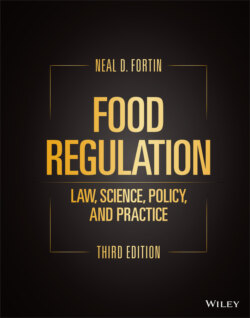Читать книгу Food Regulation - Neal D. Fortin - Страница 127
NOTES
Оглавление1 3.10 FALCPA. Before the Food Allergen and Consumer Protection Act (FALCPA), consumers did not always know the source of particular ingredients. A primary reason is that processed ingredient names do not always clearly indicate the name of the source food. For example, “sodium caseinate” is an ingredient that most consumers do not know is made from milk. FALCPA requires that the common name of the source (in this case, “milk”) must be listed as well as the ingredient name. None of the ingredient exemption listed above alleviate the FALCPA requirement. See Section 3.8 infra.
2 3.11 Corn syrup is not “corn sugar”. The Corn Refiners Association (CRA) petitioned the FDA to authorize “corn sugar” as an alternate name for high‐fructose corn syrup (HFCS). CRA argued, among other things, that consumers are confused by the name “high fructose corn syrup” and “incorrectly believe that HFCS is significantly higher in calories, fructose and sweetness than sugar.” In rejecting the petition, FDA noted that its regulations define sugar as “a solid, dried, and crystallized food,” whereas regulations provide that “syrup” is the term for a “food that is liquid or is an aqueous solution or liquid food.” The petition would also have required that FDA eliminate the use of “corn sugar” as an alternate name for dextrose. FDA noted that “corn sugar” has been used to describe dextrose for over 30 years. Changing HFCS to “corn sugar” could put consumers with hereditary fructose intolerance at risk because these individuals currently understand “corn sugar” to be a fructose‐free ingredient. FDA, Response to Petition from Corn Refiners Association to Authorize “Corn Sugar” as an Alternate Common or Usual Name for High Fructose Corn Syrup (HFCS), May 30, 2012.
